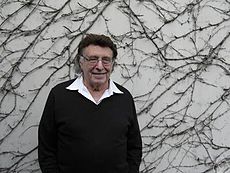Bertram Kostant
| Bertram Kostant | |
|---|---|

Bertram Kostant at a workshop on “Enveloping Algebras and Geometric Representation Theory” in Oberwolfach, 2009
|
|
| Born |
May 24, 1928 Brooklyn, New York |
| Died | February 2, 2017 (aged 88) Roslindale, Massachusetts |
| Nationality | American |
| Fields | Mathematics |
| Institutions |
Massachusetts Institute of Technology University of California, Berkeley |
| Alma mater | University of Chicago |
| Thesis | Representations of a Lie algebra and its enveloping algebra on a Hilbert space |
| Doctoral advisor | Irving Segal |
| Doctoral students |
Arlie Petters James Lepowsky Stephen Rallis James Harris Simons Moss Sweedler David Vogan Birgit Speh |
| Known for |
Kostant partition function Kostant–Parthasarathy–Ranga Rao–Varadarajan determinants |
| Notable awards | Wigner Medal (2016) |
Bertram Kostant (May 24, 1928 – February 2, 2017) was an American mathematician.
Kostant grew up in New York City, where he graduated from Stuyvesant High School in 1945. He went on to obtain an undergraduate degree in mathematics from Purdue University in 1950. He earned his Ph.D. from the University of Chicago in 1954, under the direction of Irving Segal, where he wrote a dissertation on representations of Lie groups.
After time at the Institute for Advanced Study, Princeton University, and the University of California, Berkeley, he joined the faculty at the Massachusetts Institute of Technology, where he remained until his retirement in 1993. Kostant's work has involved representation theory, Lie groups, Lie algebras, homogeneous spaces, differential geometry and mathematical physics, particularly symplectic geometry. He has given several lectures on the Lie group E8. He has been one of the principal developers of the theory of geometric quantization. His introduction of the theory of prequantization has led to the theory of quantum Toda lattices. The Kostant partition function is named after him. With Gerhard Hochschild and Alex F. T. W. Rosenberg, he is one of the namesakes of the Hochschild–Kostant–Rosenberg theorem which describes the Hochschild homology of some algebras.
...
Wikipedia
